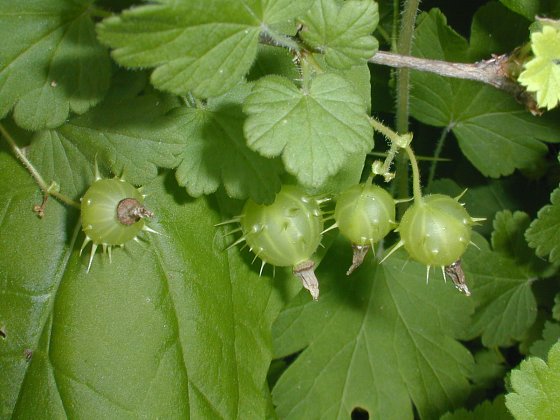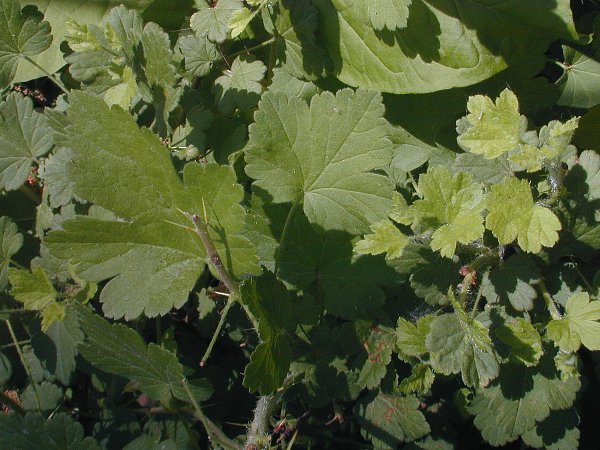Description: This woody shrub is about 2-4' tall, branching occasionally. Young branches are green, while older branches are gray or brown. They have two kinds of thorns: long thorns about ½" long that occur in groups of 1-3 near the petioles of the leaves (or where the petioles used to be located), and shorter thorns about ¼" or less that are abundant on major branches, but fewer in number or absent on smaller branches. These thorns are straight and brown to reddish brown. The leaves occur alternately along the branches in groups of 1-3. Each leaf is up to 2" long and across; it is palmately lobed and crenate along the margins. There are usually 3-5 major lobes per leaf, and several lesser lobes; they are cleft and taper to blunt tips. The upper surface of each leaf is slightly pubescent to hairless, while the lower surface is pubescent to slightly pubescent. Each leaf is cordate (indented) at the base where the petiole joins the blade. The petioles are usually hairy and up to 1½" long. Flowers are produced in groups of 1-3 near the petioles of some leaves; the inflorescence is either a branched cyme or a short raceme, from which the flowers droop downward. The slender pedicels of the flowers are green and pubescent or slightly hairy.

Each flower is
about 1/3" (8 mm.) long and greenish yellow; it consists of short
tubular calyx
with 4-5 spreading lobes, a similar number of stamens, and a prickly or
bristly ovary underneath. The short lobes are oblong to oval in shape,
while the stamens extend no farther than the tubular calyx (they are
not exerted). The petals are smaller than the calyx lobes and
insignificant. The blooming period occurs during late spring and lasts
about 2 weeks. Each fertilized flower develops into a globoid berry
about 1/3" (8 mm.) across or a little larger. Immature berries are
shiny and
green, but they later become dull red or dull purple. All berries have
conspicuous prickles. The berries are juicy and contain several minute
seeds. The root system is branching and woody.
Cultivation:
The preference is partial sun, mesic to dry conditions, and loamy or
rocky soil. In excessive shade, flowers and fruit may fail to develop.
Gooseberries and currants (Ribes
spp.) are alternate hosts to White Pine Blister rust.
Range &
Habitat:
The native Prickly Gooseberry occurs occasionally in central and
northern
Illinois, while in the southern part of the state it is uncommon or
absent (see Distribution
Map). Habitats include thin rocky woodlands, wooded slopes,
woodland borders, and limestone bluffs. Some disturbance is beneficial
to this species if it reduces the overhead tree canopy.

Faunal
Associations:
The nectar and pollen of the flowers attract bumblebees, Andrenine
bees, Vespid wasps, Syrphid flies, ants, and other insects (Graenicher,
1907; Trelease, 1881). Among these, bees are the primary pollinators of
the flowers. An Andrenine bee, the Snowy Miner Bee (Andrena nivalis),
may be an oligolege (pollinator specialist) of Ribes spp. if past
records are any indication. Other insects feed destructively on the
foliage, sap, and other parts of these shrubs. This latter group of
insects includes leaf beetles, plant bugs, aphids, leafhoppers, armored
scale insects, larvae of gall flies, larvae of sawflies, larvae of
Geometer moths, larvae of eye-cap moths (Opostegidae), and two
brush-footed butterflies, the Green Comma (Polygonia faunus) and Gray
Comma (Polygonia progne). The Insect Table
provides more information about these species. The fruits of Prickly
Gooseberry (Ribes cynosbati) and other Ribes spp. are an attractive
source of food to many songbirds and upland gamebirds (see Bird
Table). These shrubs also provide protective cover and
nesting habitat for many birds. Mammals that eat the fruits include the
American Black Bear, Raccoon, White-footed Mouse, and Deer Mouse (Noyce
& Coy, 1990; Martin et al., 1951/1961; Hamilton, 1941). These
fruit-eating animals spread the seeds of these shrubs to new locations.
Notwithstanding the thorns on some Ribes spp., White-tailed Deer
sometimes browse on the foliage (personal observation).
Photographic
Location:
A rocky bluff with oak trees in Vermilion County, Illinois. In the
photograph of leafy branches, there is some evidence of browsing by
deer.
Comments:
The most striking feature of this shrub is its prickly berries. It is
unclear what advantage this provides in comparison to berries without
prickles. Other species of plants produce prickly fruits as well –
e.g., some Opuntia spp. (Prickly Pear Cacti) have
prickly fruits that are offered for sale in grocery stores. In addition
to its prickly berries, Prickly Gooseberry can be distinguished from
other Ribes spp. (Gooseberries) by the inserted
stamens of its flowers and leaves with indented bases (cordate). Other
Gooseberries in Illinois have non-prickly berries, flowers with exerted
stamens, and leaf bases that are truncate, rounded (obtuse), or less
indented. Those Ribes spp. that are Currants have
larger clusters of flowers/berries (5 or more). Prickly Gooseberry is
more common in areas that are located to the north and east of
Illinois.